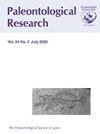环北太平洋地区晚白垩世二形舟形菊石属叶子岩
IF 0.6
4区 地球科学
Q3 PALEONTOLOGY
引用次数: 2
摘要
摘要Yezoites是晚白垩世(Cenomanian-Campanian)的一个小到非常小的二形菊石属,属于Scaphitidae,其微钩在开口处有一对长的侧向翻领。基于对先前描述的材料(包括模式和图形标本以及新发现的标本)的检查,本文描述了环北太平洋地区(日本、萨哈林、堪察加半岛、阿拉斯加、俄勒冈州和加利福尼亚州)的五种叶子岩;即来自土仑阶的P.perrini(Anderson)、Y.seaeensis(Cobban和Gryc)和Y.puerculus(Jimbo),以及来自科尼亚阶的Y.pseudoaequalis(Yabe)和Y.matsumotoi(Tanabe)。在这些物种中,小弯钩和大弯钩都在puerculus和Y.pseudoaequalis中被识别,而在其他三个物种中只知道小弯钩。这些Yezoite物种的特征是出现在非常细粒的砂岩到粉砂质泥岩相中,表明其处于近岸和近海环境之间,可补充用于北太平洋地区土仑和科尼亚阶矿床的生物分带和对比。本文章由计算机程序翻译,如有差异,请以英文原文为准。
Late Cretaceous Dimorphic Scaphitid Ammonoid Genus Yezoites from the Circum-North Pacific Regions
Abstract. Yezoites is a Late Cretaceous (Cenomanian–Campanian) small to very small dimorphic ammonoid genus belonging to the Scaphitidae, whose microconchs have a pair of long lateral lappets at the aperture. Based on examination of previously described material including type and figured specimens and newly recovered ones, five species of Yezoites are described herein from the circum-North Pacific regions (Japan, Sakhalin, Kamchatka, Alaska, Oregon, and California); i.e., Y. perrini (Anderson), Y. seabeensis (Cobban and Gryc), and Y. puerculus (Jimbo) from the Turonian, and Y. pseudoaequalis (Yabe) and Y. matsumotoi (Tanabe) from the Coniacian. Of these species, both microconchs and macroconchs are recognized in Y. puerculus and Y. pseudoaequalis, whereas only microconchs are known in the other three species. These Yezoites species characteristically occur in very fine-grained sandstone to silty mudstone facies suggesting an intermediate between nearshore and offshore environments, and can be used supplementarily for biozonation and correlation of the Turonian and Coniacian deposits in the North Pacific regions.
求助全文
通过发布文献求助,成功后即可免费获取论文全文。
去求助
来源期刊

Paleontological Research
PALEONTOLOGY-
CiteScore
1.60
自引率
0.00%
发文量
47
审稿时长
>12 weeks
期刊介绍:
Paleonotological Research (PR) is a quarterly, peer-reviewed international journal, which focuses on original contributions primarily in the area of paleontology but also covering a wide range of allied sciences. It has been published since 1997 as a successor to the former journal Transactions and Proceedings of the Palaeontological Society of Japan. The emphasis of contributions will include global and local perspectives, and contents can cover all ages (Precambrian to the Quaternary, including the present time).
 求助内容:
求助内容: 应助结果提醒方式:
应助结果提醒方式:


